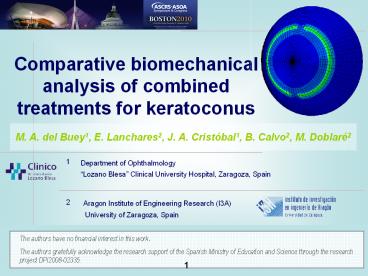Diapositiva 1
Title: Diapositiva 1
1
Comparative biomechanical analysis of combined
treatments for keratoconus
M. A. del Buey1, E. Lanchares2, J. A. Cristóbal1,
B. Calvo2, M. Doblaré2
1
Department of Ophthalmology Lozano Blesa
Clinical University Hospital, Zaragoza, Spain
2
Aragon Institute of Engineering Research (I3A)
University of Zaragoza, Spain
The authors have no financial interest in this
work. The authors gratefully acknowledge the
research support of the Spanish Ministry of
Education and Science through the research
project DPI2008-02335.
1
2
INTRODUCTION
- KERATOCONUS is a degenerative disorder of the eye
in which structural changes within the cornea
cause it to thin and change to a more conical
shape than its normal gradual curve. - Treatments
- - Intrastromal ring segments (ISRS)
- - Collagen Cross-linking (CXL)
- - Keratoplasty
PURPOSE
To compare the effects of two combined treatments
for keratoconus corneal CXL and ISRS insertion,
using a biomechanical model of the keratoconic
cornea.
2
3
METHODS Finite Element Model
FE model of a healthy cornea ( spherical)
IOP 15 mmHg
FE model of a keratoconic cornea (Thinnest apex)
Cornea
Thinnest
Surroundings f4mm
The pathologic tissue is weaker than the healthy
one. The CXL-treated tissue is 300 stiffer (G.
Wollensak E. Iomdina 2009)
3
4
METHODS Simulation of CXL, ISCR
- ISCR
- O.Z. 6 mm
- length 160º
- t 0.3 mm
- CXL
- UVA 3 mW/cm2
- Exposure time 30 min
- fbeam 9 mm
- Depth 300 mm
4
5
RESULTS
Clinical results
Decrease of the ACD caused by the implantation of
ICRS
Mean values PREOP POSTOP p
ACD 3.38 0.30 3.34 0.33 lt 0.05
K 48.85 4.68 46.43 4.17 lt 0.05
Sim K 5.95 2.60 3.66 2.20 lt 0.05
DACD0.04
5
6
RESULTS Numerical simulation
ICRS insertion
Displacement distribution (deformed shape)
Stress distribution
6
7
RESULTS Numerical simulation
1st CXL 2nd ICRS
Displacement distribution (deformed shape)
Stress distribution
7
8
RESULTS Numerical simulation
1st ICRS 2nd CXL
Displacement distribution (deformed shape)
Stress distribution
8
9
RESULTS Effect of the ICRS insertion
The insertion of ICRS causes the applanation of
the central area of the cornea (hyperopic effect)
and a decrease in the ACD.
DACD
Num.Sim. ICR 1st CXL 2nd ICRS 1st ICRS 2nd CXL
Stress (s1) 0.1501 MPa 2 MPa 0.03 MPa
DACD -0.056 mm -0.237 mm -0.045 mm
Close to clinical estimation (after ICRS
insertion) DACD0.04
9
10
CONCLUSIONS
- Our clinical results show that the ACD can be
used to quantify the hyperopic effect caused by
the insertion of ICRS. - Since the combination of both corneal CXL and
ICRS insertion techniques leads to a
regularization of the pathological cornea
regarding morphology (shape) and biomechanics
(tissue behaviour), the sequence of the
treatments was analyzed by numerical simulation.
10
11
CONCLUSIONS
- The highest value of stress corresponds to the
1stCXL-2ndICRS treatment. This is due to the
increased stiffness of the previously CXL-treated
tissue. - The outcomes show a higher effect of the ICRS
implantation (?ACD, ?s1) when a CXL treatment is
previously performed. Thus, biomechanical
simulation suggests that ICRS have less effect in
advanced keratoconus, due to the weakness of the
tissue.
madelbuey_at_telefonica.net
11
María A. del Buey
Elena Lanchares































